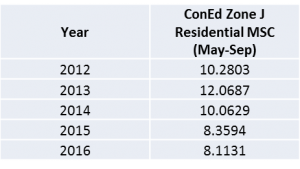New York weather is notorious for ranging from one extreme to the other. Winter blizzards and summer heat waves are par for the course in the Empire State. Fortunately, many pleasant days fall between those extremes. Our energy bills also fluctuate with the seasons. The heating season brings fuel oil bills or higher natural gas bills. The summer cooling season, on the other hand, affects our electricity bills.
Hotter New York Summers
The summer cooling season in New York generally runs from May through September. We have previously discussed the concept of cooling degree days (CDD). Every degree the average daily temperature is higher than 65° F is one CDD. This is simply a benchmark for comparing one time period or one location to another. The chart below shows how the past five summers in New York City compare.
The chart shows what every New Yorker already knows. The past two summers have been warmer than normal. Warmer summers also bring higher electricity bills. Fortunately, electricity rates have not followed the summer heat. The Consolidated Edison Market Supply Charge (MSC) for residential customers has actually moved steadily down for the May-September period since 2013. The data below is for ConEd residential customers (excluding Westchester) on standard utility service.
Electricity Rate Shopping
Of course, your electricity bill is a function of your rate and your usage. While ConEd and ESCO rates may be lower, electricity bills remain high due to increased usage. This brings up the issue of how to select the right term for your electric supply agreement.
When shopping for low New York electricity rates, you have several options on locking in a fixed rate. The most popular terms are usually in multiples of 12 months (e.g., 12, 24, or 36 months). The advantage of these electricity rates is that they blend out seasonal price differences. The next consideration is how long you want to secure your fixed price electricity rate.
There is no way of predicting the weather or energy rates over the next two to three years. Weather trends can reverse. Electricity rates can change with the natural gas prices. Economic and policy initiatives can also affect market fundamentals. These include renewable energy mandates, power plant retirements, and other variables. These factors make it impossible to recommend the best strategy. A good strategy is to select a 12 or 24-month fixed rate electricity plan with a reputable ESCO. Regardless of what happens in the market, your electricity rate is guaranteed for the term of the agreement. This is a balanced approach between short-term price security and being tied down for too long.




